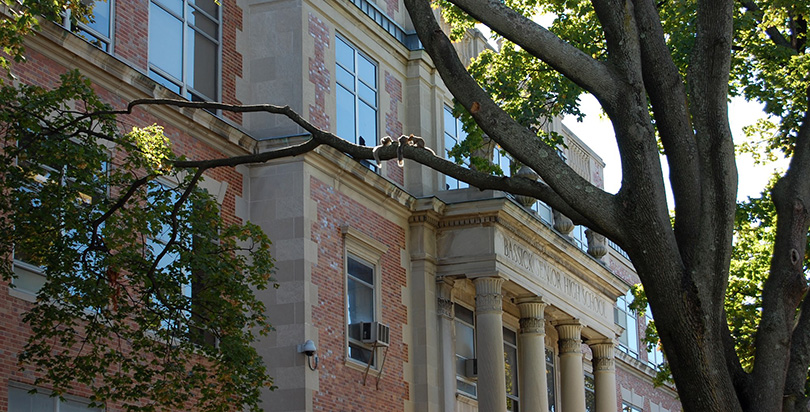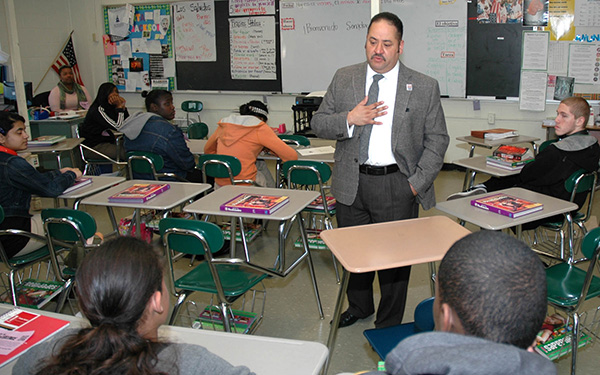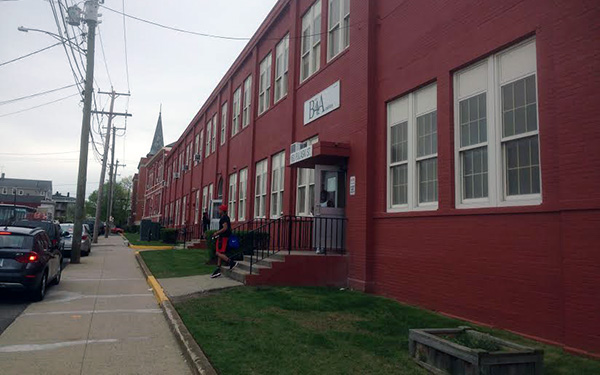Connecticut’s Shame: In One of America’s Richest Counties, a High School Has Been Failing for 50 Years

Updated May 17
“What's wrong with Bridgeport is that for quite a few years now not enough people in Washington have cared what's happening here — and in a hundred other Bridgeports across the country… What frustrates us is that in this crowded, unplanned, unlovely city, there is so much to be done that no one can tell where to start.”
— Nancy Hendrick, Bridgeport Sunday Herald, January 8,1961
— Nancy Hendrick, Bridgeport Sunday Herald, January 8,1961
(Bridgeport, Connecticut) — When veteran Bridgeport journalist Nancy Hendrick greeted the start of 1961 with a blistering column called “What’s Wrong With Bridgeport,” the inequalities that afflict the city today were already evident everywhere she looked.
“Suddenly we are all aware of the sharp contrast between private opulence and public squalor that exists within our unprecedented prosperity,” she wrote, going on to describe the “rabbit warrens” of the South End, where “the unloved, unwelcome minority groups live in jammed-in discomfort” as well as “the dilapidated sin-tenements on the East Side that should have the torch of public indignation set to them.”
Bridgeport evoked a similar response later that week among state educators wrapping up an evaluation of Bassick High School. The Connecticut Post headlined its January 12 coverage: “Report ‘Indicts’ City For Educational Ills,” telling readers that the evaluators were laudatory about the school’s teachers but withering in their assessment of the city’s lack of financial support — noting with special emphasis that students were forced to pay for their own books, science equipment, globes and maps.
“This situation makes a mockery of a free public education. Only a community grown callous over the years could allow such a condition to continue year after year,” they said. “If Bridgeport were a poor community in a poor state in a poor nation, this condition might be more easily understood.”
Fifty-five years later, Bridgeport is now largely a poor community — though Connecticut remains one of the richest states in the country — and life at Bassick High School has only gotten worse, even as the greater powers that Hendrick tried to awaken continue to largely ignore it.
The stakes are no longer who pays for books and globes but how a school that has struggled for decades can rise to the challenge of preparing students for the 21st century — for an economy that requires increasingly high levels of skill and knowledge even as low-wage jobs disappear.
Bassick must meet the challenge with overwhelmingly poor students, a state funding formula that favors students from some of the country’s wealthiest suburbs while shortchanging the neediest in cities like Bridgeport, and a policy and leadership churn — with governors, mayors, and superintendents coming and going — that prevented one reform effort after another from reaching maturity.


Former Connecticut State Senator Andres Ayala, Jr. visits Bassick High School in Bridgeport, where he used to work as a teacher, to speak with a group of students about his work as an educator and legislator. (Photo courtesy Connecticut Senate Democrats)
Even to the jaded, Bassick’s achievement statistics are disturbing. Last year, only 15 percent of students tested proficient in language arts on the new Common Core-aligned state tests. The percentage of students who met that benchmark in math? Zero.
In all, 68 Bassick students sat for 85 AP exams but scored high enough to earn college credit on only 16 tests. Among the 167 students that took the SAT, the average score on either the 800-point math or English sections did not crack 400, according to The College Board, which administers the test.
Chronic absenteeism is also an issue. Nearly half of all Bassick teenagers missed 18 days of the 2014-15 school year, compared to 19 percent of students district-wide and just 10 percent of students in the state overall. Bassick’s graduation rate in 2015 was 62 percent — much better than the abysmal 48 percent that graduated in 2012 but far worse than the 82 percent national average or Connecticut’s even-better 85 percent rate.
Bassick’s basement-level test scores prompted the reform-oriented advocacy organization ConnCan in 2013 to give the school an F rating in every single academic category. In 2012, the Connecticut Department of Education labeled Bassick High School a Turnaround School, a designation under federal education law for the worst-performing schools in the state. This year, the school was designated a Category 5 Turnaround School because it has failed to shake that distinction for three years.
Some in the community have memories far longer than that.
“The district has been failing our students over the last 20, 25 years,” said pastor Kenneth Moales Jr., a former school board member in this city on the Long Island Sound. “In the city of Bridgeport, we have 18 schools that are failing. Of those, 13 have been failing for over 10 years.
“So the question is: Is Bassick really failing, or are the schools that are sending students to Bassick failing?”
During the decades Moales refers to, efforts in Bridgeport and across the country to improve the dismal public school outcomes for poor children and students of color have involved fierce fights over policies — more social services, smaller class sizes, greater teacher accountability, increased funding — that promised to narrow the opportunity gap between the affluent and the impoverished.
While that promise went unfulfilled, youth slipped through the cracks by the thousands. The entire Chicago Public School district isn’t graduating a third of its student body. More than 1,000 schools across the nation are considered “dropout factories,” where less than 60 percent of the students graduate.
(Don’t miss a 74 investigation: Sign up for our newsletter)
The educational woes of big cities like Chicago, Detroit, New York, and Los Angeles dominate the debate but persistent failure in places like Bridgeport and schools like Bassick is just as hard to solve. Maybe harder because they go about their business from September to June absent from the national headlines and generally outside the realm of big-time school philanthropy.
As Moales, the pastor, put it: “Bridgeport is a microcosm of low-performing school districts (all over) the country.”
The school is now in the midst of yet another reboot, about to get its third principal in three years. Bridgeport administrators say they recognize the challenges but are confident that a new leader can give Bassick the foundation for a sustainable comeback. The Board of Education voted last week to hire Tomas E. Ramirez, a 56-year-old Rhode Island educator, for the $141,561-a-year job.
“I feel optimistic about the leadership that will be coming forward in the school. I do believe we have a leader who will remain with us and who will lead that school forward with consistency, with input and with high expectations for students,” said Fran Rabinowitz, the well-regarded interim schools superintendent who earlier in her career spent 29 years in the Bridgeport schools.
“I know those people at Bassick and I believe there is pent-up capacity for moving forward and moving forward in a positive way. So I am incredibly optimistic.”
But some parents like Dione Dwyer say they can’t wait around any longer for Bassick to improve. After her older daughter started to struggle academically and behaviorally at Bassick, she knew she had to make a change. She worked three jobs — at times clocking seven days a week — so she could send her younger daughter to Bridgeport International Academy, a small private school.
Her teenager takes two city buses, starting at 6:50 a.m., to get to school on time — a sacrifice the family happily makes for the education she is receiving there. Sometimes, Dwyer wonders what might have happened if she had been able to get her oldest child away from Bassick.
“I had no choice,” she says now. “This was the neighborhood school.”


A shuttered factory sits empty on September 18, 2011 in Bridgeport, Connecticut. (Getty Images)
You wouldn’t know it by looking at Bridgeport
Bassick High School first opened as a middle school in 1929 to meet the demands of a city that had grown several times over in recent decades with European immigrants seeking jobs in hundreds of factories across several industries. Sewing machines, corsets, guns, and later record albums were all made in Bridgeport. In 1968, the district built a new addition and the state’s only high school astronomy observatory opened at Bassick — a reflection of the era’s space craze.
Today, Bassick High School borders the busy street of Fairfield Avenue across from a rundown auto shop and corner gas station. The school’s entrance hints at the city’s past grandeur, with tall white columns ascending above a steep staircase. A school board meeting earlier this year, however, reflected the current disrepair. The board approved $1.5 million to finally fix the school’s leaking roof, prompting The Connecticut Post to write, “Those of you who sit under an often leaky roof at Bassick High School, dodging the rodents that are rumored to scurry about, may not believe this but plans really are underway to replace the roof this summer. It’s true.”
‘Everybody said that was the seminal moment when their (school’s) reputations changed’
Bridgeport resembles many American cities struggling to regain their 20th-century prosperity after the factory jobs disappeared and the middle class took its money and its social capital to the suburbs. The city’s sprawling green spaces along the waterfront and gracious parks, some designed by famed Central Park creator Frederick Law Olmsted, earned Connecticut’s most populated urban center the nickname “Park City.” But the community is perhaps better known for its long line of corrupt politicians, including current Mayor Joe Ganim, who spent five years in prison for embezzling taxpayer dollars only to be re-elected last year.


Despite some of the poorest cities in the country, Connecticut has the third highest average median income in America. (Photo by Getty Images)
Poverty and violence persist. Bridgeport is commonly labeled one of the most dangerous cities in the U.S. Newscasts regularly report on the latest murder or shooting. What’s particularly striking is how much the city contrasts with the area around it.
Of the racially diverse population — which numbers close to 150,000 — almost 20 percent are living in poverty, including a quarter of all the city’s youth. But just 12 miles away in Westport, where Martha Stewart and Paul Newman once lived beyond the Maserati dealership, the poverty rate is only 2.6 percent.
“Fairfield County is one of the richest counties in America but you wouldn’t know it by looking at Bridgeport,” said Eric Lehman, an English professor who teaches Connecticut history at The University of Bridgeport and is author of the book, “Bridgeport: Tales from The Park City.” “There’s a huge disconnect.”
Nowhere is that economic divide more apparent than in the schools. Connecticut lawmakers long ago established the Education Cost Sharing formula, a plan to bridge the difference between the revenue a community is able to raise from property taxes and the actual cost of running its public schools. The state has not fully funded the formula for years.
A coalition of education groups filed a lawsuit in 2005, complaining that the state was failing to fund schools adequately or equitably. After more than a decade in the state court system, it is now being argued before Connecticut’s Superior Court.
(Related — Connecticut School Funding on Trial: Equity Gets its Day in Court)
The plaintiffs’ claims were buttressed by a newly released report from the U.S. Department of Education that found Connecticut spent 8.7 percent less per student in its poorest school districts than it did in its most affluent.
In Bridgeport, that comes out to $13,883 per student compared to the state’s $15,700 per-student average and ultra-wealthy Greenwich’s $20,747 per-pupil, according to the Connecticut School Finance Project. This difference leads to sharp inequality in a student’s experience of school. Bassick had four guidance counselors for its 1,200 students in the 2012-13 school year, for instance, while Greenwich’s 2,700 students were served by 18 guidance counselors, according to the lawsuit. A recent New York Times data analysis of wealth and school achievement found that Bridgeport sixth-graders were lagging nearly two grade levels behind while their Greenwich peers were typically two grade levels ahead.
Starting salary for a teacher with a master’s degree in Bridgeport is $44,101; five miles away in Trumbull, it’s $57,516, according an analysis by Bridgeport Public Schools.
“Teachers don’t have enough resources in the classroom,” said Moales, the former Bridgeport school board member. “It’s like hiring an electrician and not giving them all the tools. It’s only a matter of time before you start having problems with the power. That’s what we’re doing.”
When Timothy Dutton, the director of a charter high school, first started teaching in the city more than 20 years ago, he said old-time educators would talk about the moment they saw Bassick High School and Harding High School, another of Bridgeport’s struggling comprehensive high schools, start to sharply decline: In the 1970s, when affluent parents asked for — and received — a magnet program at Central High School, which Dutton said, takes some of the highest-performing students out of other city schools.
"Everybody said that was the seminal moment when their (school’s) reputations changed,” said Dutton. "The hardest part about all of this is, you can't blame a parent for wanting a more advanced program.”


Bridge Academy, one of two charter high schools in Bridgeport, has 224 students on its waiting list, most from families hoping their children will have a better chance there of graduating and going onto college. (Photo by Naomi Nix)
Dutton started The Bridge Academy 19 years ago after teaching at Harding convinced him the city needed a smaller high school. The roughly 180 students enrolled at Bridge Academy in grades 7-12 are mostly disadvantaged minority students, including close to 15 percent who have disabilities. (The district special education percentage is 13) The school doesn’t have the capacity to offer many specialized classes or sports teams. Yet there are 224 students on its waiting list, Dutton said, from families looking for a smaller, safe environment in a school that often does a better job of preparing students to graduate and go to college than its public school counterparts. Its graduation rate is 88 percent.
But Bridge Academy accepts only 30 new high school students a year.
There is one other charter high school in Bridgeport, Capital Preparatory Harbor School , and five other charter elementary and middle schools. The climate towards school choice has grown more hostile in Bridgeport (and beyond) as larger, high-performing operators, such as Achievement First, whose New Haven charter high school ranks among the best in the country, moved in. The Connecticut Education Association, the state teachers union, has tried to kill charter school funding in the state legislature and criticized the qualifications of Achievement First’s teaching staff.
“The charter school environment has become much more toxic in the last four or five years,” Dutton said. “When I first started it was pretty much benign neglect… now there are people who don't want to have anything to do with charters.”
Turnaround — and around
In 2009, President Obama offered funding to school districts across the country to improve their most persistently struggling schools. In exchange, they would have to adopt what were considered one of four sweeping turnaround models first used by Obama’s education secretary, Arne Duncan, in the late 1990s when he was steering Chicago’s troubled public schools.
“We want transformation, not tinkering,” Duncan famously declared in a 2009 speech introducing the national program.
In order to get that in Chicago, Duncan had given leaders at some of the lowest-performing schools several choices: replace the principal and some of the staff, close and restart the school fresh or turn the school over to a private management organization or the district’s own school improvement office. The University of Chicago Consortium on School Research found that struggling elementary schools that used one of these strategies were able to reduce the gap between their students’ math and reading scores and the district’s overall scores by almost half after four years. But similar reforms did little to dent chronic absenteeism or poor graduation rates at Chicago’s worst high schools.
When the district took more time to plan its turnaround strategy in a second generation of failing high schools it had better — but still uneven — results, said Marisa de la Torre, the consortium’s director for internal research capacity.
“What you see over and over is that these turnaround efforts, they are a process,” she said. “It’s not going to happen overnight.”
High school turnaround is generally seen as one of the hardest tasks in urban education. One of the few places to experience success was New York City which improved the education of students slated to attend the lowest-performing schools by closing them and opening new, smaller high schools. Other states have been able to improve failing high schools by bringing in new leaders who supervise smaller learning communities under programs such as The Talent Development High School Model and First Things First.
"What works in one city is not necessarily going to work in another city or even in another high school," said James Kemple, executive director of the The Research Alliance for New York City Schools which studied that city’s controversial closure model.


Former U.S. Education Secretary Arne Duncan, during his time as CEO of the Chicago public schools, was the architect of a school turnaround program that President Obama would later take nationally, sending millions of dollars in grants to chronically failing schools, including Bridgeport's Bassick High School. (Photo by Getty Images)
Far smaller in scope and with nowhere near the resources of New York City, Bridgeport set out on its own pursuit of transformation in 2010 when it received one of Obama’s $2.1 million School Improvement Grants to remake Bassick High School. Then-Superintendent John Ramos took the approach that stipulated replacing the principal but retaining the rest of the staff, with a heavy emphasis on professional development, curriculum improvement, and expanded learning time.
Reading the application Bridgeport filed with the U.S. Department of Education to win the grant offers a glimpse into what Bassick was like in the 2007-08 school year when the school reported 881 disciplinary offenses.
Parent Evelyn Medina remembers those days. She often feared for her children’s safety, she said, frequently receiving messages that the police had locked down the school because of another serious fight.
Medina’s children knew to walk away from violent incidents, but that didn’t mean their school experience was challenge-free. They struggled to keep up in their classes. Her daughter was slated to graduate in 2010, but dropped out in her senior year.
Her son, with dreams of becoming a mechanic, persisted through tough classes. Three years ago, Medina and her daughter watched with pride as he got his diploma. Still, the moment was bittersweet for her daughter, who by that time had a child and a job but no degree.
“The only thing she said was ‘He made it and not me,’” Medina said. “She started crying. ‘Why didn’t I finish?’”
Why didn’t she and why didn’t so many others? Ramos, the superintendent, had some ideas about why students were flunking out or just walking away from school and what could be done to change it. He entered into a three-way partnership with the teachers unions and the University of Connecticut called the CommPACT Community Schools Collaborative. The thinking was the best solutions for improving Bassick would bubble up from teachers in the classroom and really take hold if parents were part of the process. With the former principal gone, Ramos tapped Alejandro Ortiz to lead Bassick through this period.
“Teachers wanted this model in the high school,” said Michele Femc-Bagwell, director of the collaborative. “They really owned the challenges. They owned the change.”
That first year the group made quick and simple improvements to school culture. They painted the inside of the building and required students to wear uniforms. They hired a new specialist who would mentor students to prevent them from dropping out, Femc-Bagwell said.
The school used SIG funds to hire extra reading teachers, establish a literacy program, start a peer mentoring program, create a Saturday academy for struggling students and offer a program to help students make up credits from failed classes. The school also hired an administrator to focus on improving student test scores. Ninth- and 10th graders were placed in separate academies where teams were set up to gather their data and use it to give underclassmen more targeted instruction.
CommPACT also started and staffed a large parent resource center to help parents with the everyday struggles of poverty while also involving them in their teenagers’ education.
Former state Education Commissioner Stefan Pryor toured Bassick with reporters in December 2011, declaring that the chronically underperforming high school had entered a “new era.”
“You all have created the track record, the best practices right here at this school that we can build upon,” he said.
But Bassick soon found itself amid more upheaval. In July 2011, then-Mayor Bill Finch and Gov. Dannel Malloy orchestrated a behind-the-scenes state takeover of the school district in response to what they saw as an irreparably dysfunctional school board.
The new state-appointed board fired Ramos, the superintendent, and hired the reformer Paul Vallas, a big-city schools chief with experience in Philadelphia, Chicago, and New Orleans.
And then just months after Vallas was hired, the state Supreme Court ruled the state-appointed school board had been created illegally and ordered control to be returned to the locally elected board.
During his tenure in Bridgeport, Vallas worked to stabilize the district’s finances after years of budget deficits. He also secured an $11 million grant to help the city’s four new magnet high schools — which admit students by lottery and do not include Bassick — offer top-of-the-line career-readiness programs. He deployed thousands of Chromebooks and hundreds of smart boards to city classrooms.
During his tenure in Bridgeport, Vallas worked to stabilize the district’s finances after years of budget deficits. He also secured an $11 million grant to help the city’s four new magnet high schools — which admit students by lottery and do not include Bassick — offer top-of-the-line career-readiness programs. He deployed thousands of Chromebooks and hundreds of smart boards to city classrooms.
“The strategy was simple: Improve the quality of schools but buy yourself time (for those improvements to work) by expanding choice,” Vallas told The 74.
At Bassick, Vallas brought in a new principal named Wayne Alexander, who shared his reform-oriented philosophy. Sensing there was a new order at Bassick, CommPACT organizers said they dialed back their presence in the school.
“When the new administration came in, we were still very dedicated to Bassick,” said Femc-Bagwell. “We all believe in the students. What we decided to do at that point was to remain there but to focus in on the parent and the community piece.”
Vallas’ assessment was that the CommPACT initiative faded more because the SIG grant ran out than anything else.
Vallas hoped to transform Bassick into three thematic academies — in part, to make the school feel smaller and in part to offer more compelling curriculum. His administration planned to create a Performing Arts Academy in partnership with the Bridgeport Performing Arts Center; an engineering-focused program that would operate in conjunction with The University of Bridgeport, and an automotive engineering program, according to Vallas.
Those plans never fully got off the ground. In November 2013, Connecticut’s Working Families Party organized a surprisingly large election-day turnout, helping to put in place a new school board majority that opposed Vallas’ reform policies and questioned his qualifications to serve as a superintendent in Connecticut. Shortly afterwards, former Illinois Gov. Pat Quinn tapped Vallas as his running-mate for the 2014 gubernatorial race in Vallas’ home state. The reform superintendent made his exit.
Four years after Ramos initiated the federally funded effort to “transform” Bassick, the new era heralded by the state education commissioner during his visit had begun to look a lot like the old one.
Just this month, four area university presidents joined in a letter to the current state commissioner asking her to intervene, saying the dysfunction of the Bridgeport school board “called into serious question the board’s ability to carry out its charge.”
‘Pockets of excellence’
In October 2013, a visiting committee of educators from the New England Association of Schools and Colleges spent four days in Bridgeport meeting with Bassick teachers, administrators, and students to determine whether the school should remain accredited.
In their 80-page report, evaluators noted that the school conveyed a “sense of family and belonging,” teachers had positive attitudes, and the principal was a strong presence throughout the school.
“It is clear that Bassick students are connected to the school and especially to the adults in the school,” the evaluators wrote.
They also criticized what they described as uneven teaching, however, with some classrooms led by “exemplary” teachers who held high expectations for students but “far too many” failing to assign rigorous tasks or allowing students to become distracted or disruptive during class.
“To be sure, faculty at Bassick are hindered by an aging building, insufficient technology and inadequate instructional supplies,” the report said. “It is also true that Bassick faculty teach students who are often reading well below grade level.
“Nonetheless, pockets of excellent learning experiences exist at Bassick despite these obstacles. Further, students who are reading and writing below grade level are capable — and deserving — of learning activities that are rigorous and that demand higher order thinking skills.”
In the end, Bassick kept its accreditation — with a warning — and was required to submit ongoing progress reports showing it was working toward the committee’s recommendations.
No superintendent ‘worth their salt’ will want to come to Bridgeport, board member Joe Larcheveque observed
Rabinowitz, the interim schools chief who gave up a chance to be state education commissioner to commit another year to Bridgeport, said when she first evaluated Bassick in her new position in 2014 , she identified two main challenges: the deplorable condition of its 85-year-old old building and the wide variation of talent among the teaching staff.
“The school is physically horrible. We need a new school. I’ve been fighting for that since the day I came in… It’s not a school that I think is conducive to the education of our children,” said Rabinowitz. “With that said, I have been in classrooms and I’ve seen some stellar teaching and I’ve seen some teaching that’s not so stellar. It’s variable. I’ve also seen way too many kids not in class, not necessarily hanging out in the school but nowhere to be seen. I might see 16 or 18 on the roster but only seven or eight in class.”
Bridgeport schools requested more SIG funds for Bassick as well as for the school to be part of a state-run turnaround program similar to the Obama initiative. Both were denied. Obama said at the time he renewed the federal funds in 2014 that many of the schools receiving SIG grants were improving. “That has not been the case in Bridgeport,” the Connecticut Post reported, “where Harding and Bassick high schools, recipients of millions in SIG dollars, have yet to see substantial test score improvement.”
Rabinowitz, meanwhile, got embroiled in a controversy with parents and some school board members over who should be Bassick’s next principal. A community group wanted Byron Williams, a former principal of Bridgeport’s military academy high school.
“I thought he would be the kind of leader that young black males and young females and also Hispanic (students) could relate to,” said parent Milele Ferris, whose two children graduated from Bassick and whose grandson is on his way there.
Rabinowitz said Williams was prevented from taking the job by a personnel issue that could not be discussed publicly. The issue blew up at a board meeting and in the local newspaper and the two other principal candidates dropped out.
A week before school started, Rabinowitz called Peggy Moore, a former principal from New Haven, and asked her to come out of retirement to lead Bassick as an interim.
A host of programs have been put in place under Rabinowitz to try and keep Bassick students interested and on track to graduate and to address their learning deficits. Reading and math intervention programs are given to the ninth-graders and some classes at all grade levels begin with cognitive conditioning exercises designed to help below-grade-level students hone their critical thinking skills.
Special attention is focused on freshman attendance and credit retention. If students are in danger of failing or not earning enough credits, they meet with school staff to sign a contract detailing how they will right their course. If they arrive late, they must stop at the principal’s office to get a pass before they can go to class. The freshman monthly attendance rate now regularly surpasses 90 percent.
“If you don’t catch them (as 9th-graders), you lose them,” said Kathy Silver, a much-loved former art teacher who is now the freshman academy assistant principal.
Bassick introduced career pathways in business and science and technology, a program made up of theme-based electives across grade levels. There are six Advanced Placement classes and other opportunities for students to seek college-level work at local community colleges. Jan Blevins teaches the college writing course to help prepare the seniors. It’s in their free writing assignments that Blevins said she sees the challenges her students face.
“It’s difficult to say ‘My dad is beating my mom’. Or a big one: ‘I’m scared to go to college,’” Blevins said. To students with the latter concern she responds, “Of course you can make it!”
Rose Charles, 19, and Jada Pickett, 18, both seniors, have their lives after Bassick planned out. Charles, who plans on attending Clark University in Worcester next year, said Bassick is “what you make of it.” She and Pickett said the school has gotten a lot safer compared to their freshman and sophomore years when fights were common. Student arrests district-wide have gone down dramatically from more than 280 a year to 40. Both girls are a little jealous of the younger students who will have more access to class computers and smart boards.
Since the school was first awarded its 2010 School Improvement Grant, graduation rates have declined and then risen again. Scores on the SAT remain low and students continue to lag behind their peers on the state standardized test. Of those who graduated from Bassick in 2014, only about a third enrolled in college the following fall but 80 percent of them — a bright spot — returned for their second year, according to state statistics.
Still, uncertainty about Bassick’s future remains. The district is trying to make up a budget deficit of at least $2.5 million, which could lead to layoffs and cuts to other services. Meanwhile, some members of the fractious Bridgeport school board are openly hostile to Rabinowitz at the same time they are trying to attract her permanent replacement.
No superintendent “worth their salt” will want to come to Bridgeport, board member Joe Larcheveque observed.
Moales, the pastor and former board member, is disappointed by what he said is Bassick’s and other Bridgeport schools’ too-slow progress. He thinks drastic actions would need to be taken to get the results students deserve.
”It’s frightening,” Moales said. ”Bridgeport is going to struggle for another seven to 10 years easily.”
But Ferris, the parent leader, is more cheerful about Bassick’s future. “I just think it has the potential to be a great school,” she said. “It’s not just money. We need the leadership. We need to build more community relationships. We need to build our parent component.”
For Dwyer, the mom who worked three jobs to send her younger daughter to private school, those efforts might not come soon enough. She said she knows Bassick has been making improvements but she is not sure if it will be ready to give her 11-year-old son the education she so wants him to have.
“I try not to think about that,” she said.
Get stories like these delivered straight to your inbox. Sign up for The 74 Newsletter

;)
